Mabamba Swamp
Mabamba Swamp exemplifies Uganda’s natural abundance. Despite its relatively modest size, Uganda is among the premier destinations for avian observation globally. The remarkable diversity and abundance of avian species is simply astonishing. Mabamba Bay Swamp is one of the most significant birding locations in Uganda. The Mabamba wetland, translating to “lungfish swamp” in the Luganda dialect, is situated conveniently between Kampala city and Entebbe town, enabling birdwatchers to observe numerous renowned Uganda bird species without traveling to more distant parks.
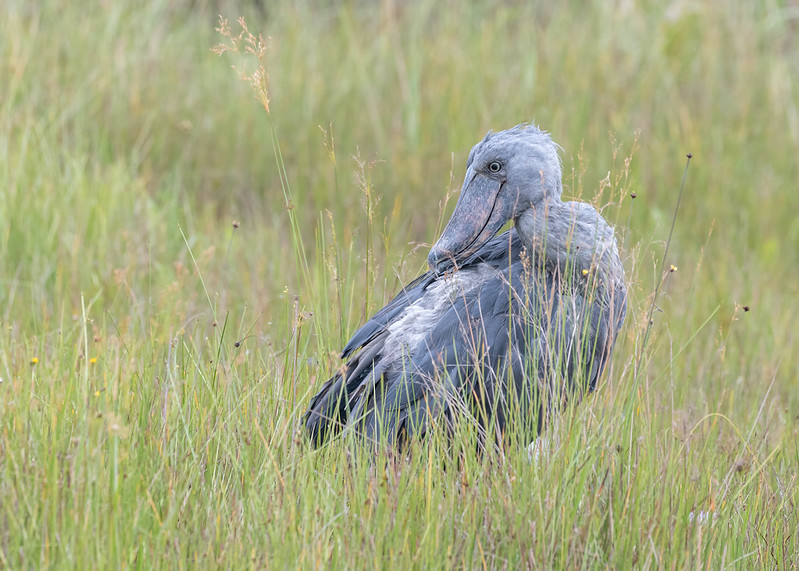
Mabamba Bay Wetland is a significant marsh located in Lake Victoria, Uganda. It is situated near Entebbe town (40 km) and Kampala city in a little settlement in Kasanje. The primary economic activities of the communities residing around the marsh include hunting, fishing, and mining. Mabamba Swamp is distinguished for its remarkable avian diversity, with over 260 species documented. Entebbe is a premier tourist destination in Entebbe. In 2006, the swamp was designated as a Ramsar Site and recognized as a wetland of worldwide significance due to the presence of rare and notable avian species, including the Papyrus Yellow Warbler, Shoebill Stork (Balaeniceps rex), Blue Swallow (Hirundo atrocaerulea), and sitatunga (swamp antelope), among others. The Ramsar Convention on Wetlands is an intergovernmental pact that promotes the conservation, prudent utilization, and protection of wetlands and their resources. The convention was enacted in 1971 in Ramsar, Iran.
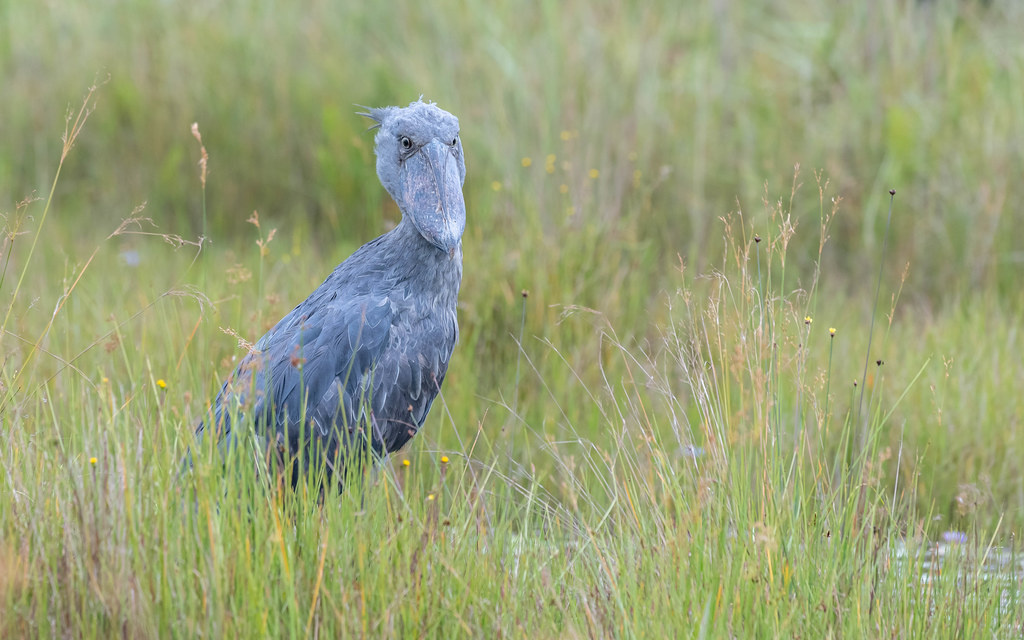
The Mabamba Swamp has attained worldwide recognition, designating it as an Important Bird Area (IBA), hence attracting numerous birdwatchers to Uganda. It is among the premier locations for birding safaris in Uganda. Due to its proximity to Entebbe International Airport, it serves as an optimal launch point for individuals seeking an extensive safari in Uganda. The primary attraction is the Shoebill Stork at Mabamba Swamp. Mabamba Swamp, in conjunction with Murchison Falls National Park, is the premier location for observing the Shoebill Stork.
Shoebill storks can be observed during the day in Mabamba and Murchison Falls National Park. The Mabamba swamp is home to more than just Shoebill Storks; it serves as a sanctuary for four endangered species: the Papyrus Gonolek, Blue Swallow, Pallid Harrier, and White-Winged Warbler. Other species found in the swamp include the Yellow-throated Greenbul, Yellow-rumped Tinkerbird, Yellow-billed Tinkerbird, Yellow-billed Ducks, Yellow-backed Weaver, Yellow warble, Yellow Wagtail, Yellow-Billed Stork, Yellow-billed duck, Yello-billed Kite, Woodland Kingfisher, Wood Sandpiper, Winding Cistocola, White-winged Warbler, White-winged Black Terns, White-throated Bee-eater, White-shouldered Tit, White-faced Whistling-duck, White-browed Cuckoo, Birding in Mabamba SwampWhite-browed Coucal, Whiskered Terns, Whinchat, Weyn’s Weaver, Weaver birds, Water Thicknee, Violet-backed Sterling, Village Weaver, Veilots’ Black Weaver, the Blue Swallow, Tawny-flanked Prinia, Tawny Eagle, Tambourine Dove, Swamp Flycatcher, Stripped Kingfisher, Squacco heron, Spur-winged, Spur-winged Lapwing, Spur-winged Geese, Speckled Mousebird, Slender-billed Weaver, Slender-billed Gull, Shining Blue Kingfisher, Sand Martin, Sand Martin, Saddle-billed Stork, Ruppell’s Long-tailed Sterling, Rufous-napped Lark, Rufous-bellied Herons, Ross’ Turaco, Red-shouldered Cuckoo Shrike, Red-headed Love-bird, Red-eyed Dove, Red-chested Cuckoo, Red-billed Fire-finch, Pygmy Geese, Purple Bird watching in Mabamba SwampHeron, Pint-tailed Whyda, Pink-backed Pelican, Pied Wagtail, Pied Kingfishers, Papyrus yellow warbler, Papyrus Gonolek, Papyrus Canary, Pallid Harrier, Orange Weaver, Olivaceous Warbler, Nothern Brown-throated Weather, Mosque Swallow, Marsh Harrier, Malachite Kingfisher, Long-toed Lapwings, Long-tailed Cormorant, Long-Crested Eagle, Long tod lapwig blover, Little Stilt, Little Egret, Little bee-eater, Levaillant’s Cuckoo, Lesser Jacana, Intermediate Egret, Harmerkop, Hadada Ibis, Gull-billed Terns, Grosbeak Weaver, Grey-rumped, Grey-Headed Sparrow, Grey-headed Kingfisher, Grey-headed Gulls, Grey-crowned Crane, Grey Woodpecker, Grey Wagtail, Grey Parrot, Grey Heron, Green Cuckoo, Great White Pelican, Great White Egret, Great Cormorant, Great Blue Turaco, Grassland Pipit, Goliath Herons, Glossy Ibis, Fulvous Whistling-duck, Fork-tailed Drongo, Fork-tailed Drongo, Fly catcher, Flappet Lark, Feral Pigeon, Fan-tailed Widowbird, Eurasian Hobby, Bird watching in Mabamba swamp and wetlandEastern Grey Plantain Eater, Double Toothed Barbet, Crowned Hornbill, Comrants, Common Waxbill, Common Stonechat, Common Sqacco Heron, Common Sandpiper, Common Moorhens, Common Greenshank, Common Bulbul, Cattle Egret, Carruther’s Cisticola, Brown Snake-Eagle, Brown Parrot, Blue-headed Cuckoo, Blue-headed Coucal, Blue-cheeked Bee-eater, Blue Swallow, Blue headed coucal, Blue Breasted Bee-eater, Black-winged Stilt, Black-headed Weavers, Black-headed Heron, Black-faced Rufous Warbler, Black-crowned Waxbill, Black-crowned Night Heron, Black- headed weavers, Black Headed Gonolek, Black Headed Gonolek, Black Egret, Black Crake, Banded Martin, Ashy Flycatcher, Ashy Flycatcher, Angola Swallows, Afrikan Jakana, African water rail, Pallid Harrier, African Water Rail, African Pygmy Goose, African Purple Swamp-hen, African Pigmy Goose, African Pied Wagtail, African Marsh Harrier, African Jacana, African Hoopoe, African Green Pigeon, African Fish Eagle, African Firefinch and African common Moorhen.
What to know about mabamba swamp and shoebill watching
Locally referred to as “Bbulwe,” the Shoebill Stork derives its name from its large, shoe-shaped bill. The Shoebill stork is the most coveted avian species in Uganda. It is a reticent and captivating avian species with an enigmatic physical appearance. The most prominent characteristic is a big, irregular, yellow bill. Shoebill storks are seen by some as unattractive birds that resemble a creature from the Jurassic era. Contrary to popular belief, both visitors and experienced birdwatchers find them quite intriguing. Numerous birdwatchers converge in Uganda just to observe these sizable avians.
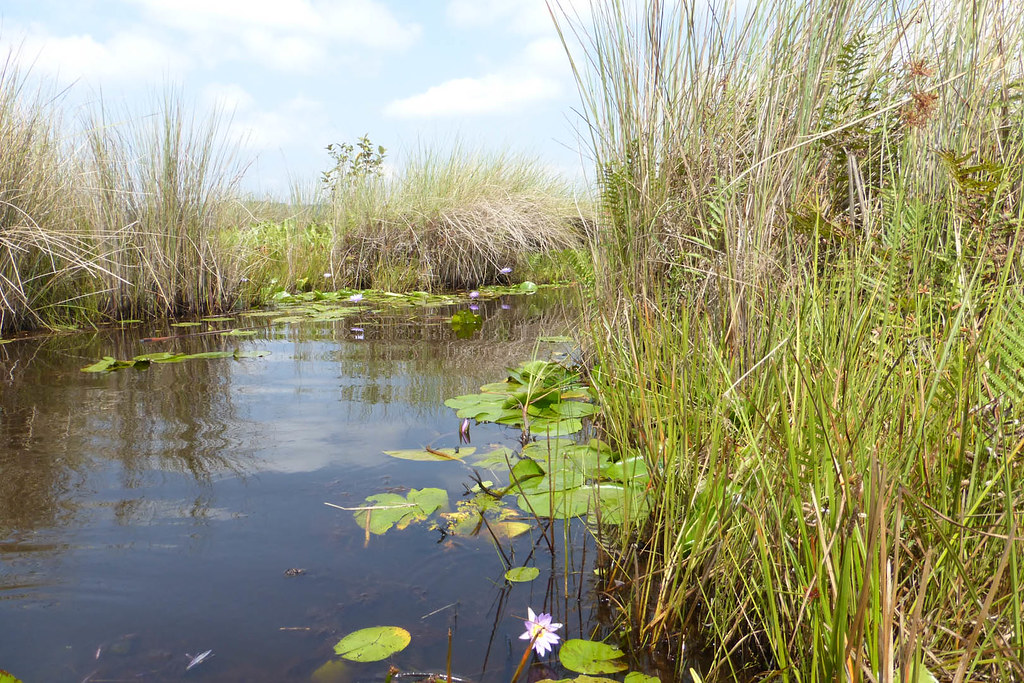
Shoebills inhabit the papyrus swamps of Sub-Saharan Africa, specifically in the Democratic Republic of Congo, Zambia, Tanzania, Uganda, and Sudan. Uganda has approximately 1,000 inhabitants. Shoebill Storks in Uganda can be observed in Queen Elizabeth National Park (Ishasha Sector), Nabajuzi Swamp (Masaka), Murchison Falls Park, Ziwa Rhino Sanctuary, Lake Mburo National Park, Semliki Wildlife Reserve, and the vicinity of Lake Kyoga. Shoebill storks mostly consume Lungfish but will also prey on smaller aquatic birds, water snakes, frogs, lizards, turtles, juvenile crocodiles, snails, and rodents. The preferred cuisine in Mabamba is Lungfish. The fish flourish in this area due to the fact that many Baganda individuals abstain from consuming them. One of the clans of the Baganda is named after the lungfish.
Mabamba Swamp in Uganda is home to a single Shoebill Stork. Two pairs unite solely during the breeding season. The breeding season typically transpires during the dry season, perhaps to avert damage to nests from severe flooding. Females deposit one to three eggs. Both the male and female participate in incubation until the chicks emerge. Following hatching, the pair are responsible for nourishing their offspring until the young can independently forage for sustenance. It requires approximately 3 to 4 years for the juveniles to commence reproduction. Typically, only one individual reaches adulthood (the most robust one). Adult Shoebills weigh approximately 14 pounds and can survive for over 50 years. A more detailed article regarding the Shoebill Stork is available.
Directions to Mabamba Swamp and Wetlands
Mabamba Bay Swamp is accessible from both Kampala and Entebbe. Travelers originating from Entebbe may utilize the ancient Entebbe-Kampala road and diverge at Kisubi. One travels from Kisubi to Nakawuka, then to Kasanje, finally arriving at Mabamba. Individuals arriving from Kampala have two alternatives. The initial option is to procure a cab from the new taxi park to the Kasanje commercial district. Upon arriving in Kasenje commercial centre, one may rent a boda boda (motorcycle taxi) to Mabamba, located 13.5 kilometers distant. Alternatively, one may utilize the Masaka route and diverge after approximately 30 kilometers towards Buyege. The distance from Buyege to Mabamba is approximately 22 kilometers.
To access Mabamba Swamp, a more convenient method from Entebbe town is to utilize a speedboat across Lake Victoria, rather than using the aforementioned road. The lake route offers a more adventurous experience, enabling one to appreciate the stunning Lake Victoria while circumventing Entebbe town and the airport. Traveling by speedboat to the starting site in Mabamba requires approximately 45 to 50 minutes. Speedboats are available for hire at select hotels in Entebbe or at the Entebbe Sailing Club. The boats are in excellent condition, comfy, and equipped with life jackets. Nevertheless, these huge speedboats are unsuitable for traversing the papyrus marshes. Upon approaching the Mabamba wetland, one must prepare to embark on smaller canoes utilized for traversing the papyrus swamp.
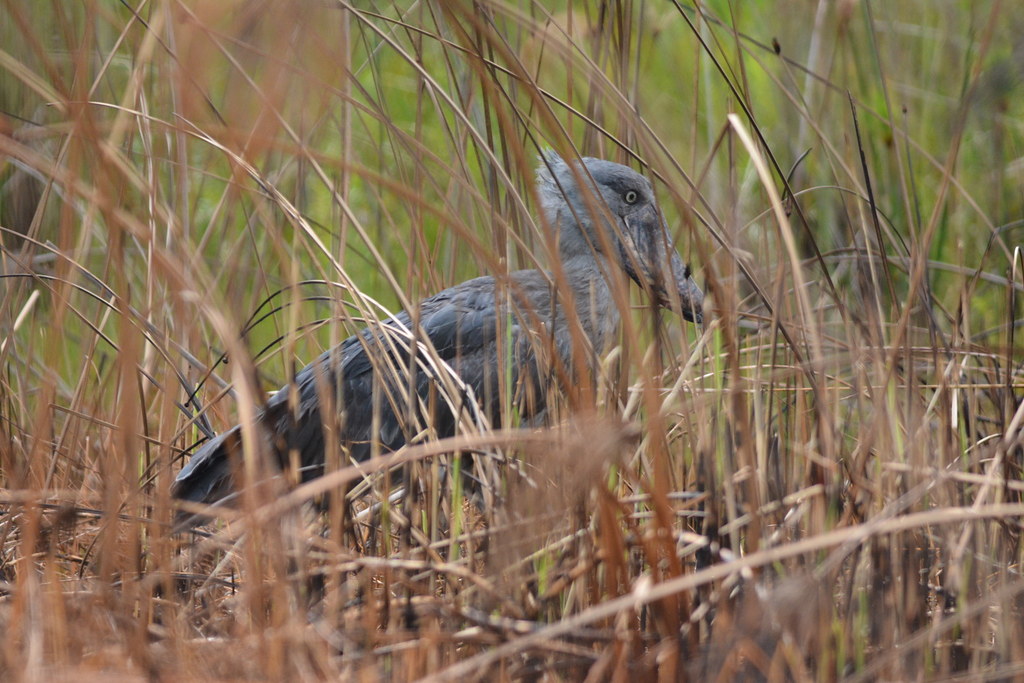
Upon arrival at the designated starting site, anticipate encountering numerous birding guides and fisherman prepared to lead you into the wetland for birdwatching. The boatmen and avian guides are efficiently coordinated. They possess a spokesperson who articulates their perspectives. The spokesman designates a boatman and guide for tourists. The canoes accommodate a maximum of three birders, not including the guide and boat operator. Initially, you must remit a community levy of approximately $7 at their little office. The combined cost of the boat and guide is approximately $35. It is necessary to either wear a life jacket or request one, as many boats lack this safety equipment. The proprietors of these vessels and avian guides are residents from the adjacent settlements. By compensating for their services, you contribute to the community and assist in the preservation of avian species and other fauna in the wetland. Individuals are less predisposed to annihilate something which is advantageous to them.
Birdwatching in Mabamba Wetlands
As the boat navigates through the reeds, remain vigilant on both sides of the tight passages and in the sky. Your guide and boatman will assist you in approaching the birds by maneuvering through the papyrus and lily pads. Following several minutes of rowing, the slender papyrus reeds part to disclose expansive, level grassy wetlands. Prepare your binoculars and camera. The quantity of birds present here will astonish you if you are unprepared. Be vigilant regarding the bee-eaters, kingfishers, and additional species. Do not overlook the exquisite butterflies and lotus blossoms. The optimal time to observe Shoebills is in the morning when they forage for food. Photographing storks is less challenging than capturing images of many other avian species. This is due to their prolonged stillness while they monitor the movements of fish, frogs, and other prey before executing a swift strike. They sustain themselves by standing on buoyant reeds.
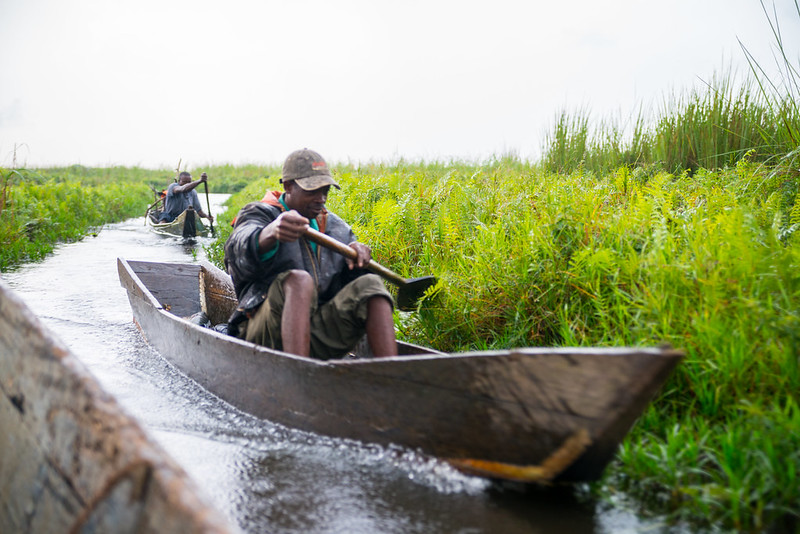
The Mabamba marsh in Uganda offers a great probability of encountering Shoebills. The elevated success rate can be attributed to the exceptional collaboration and teamwork among the Birding guides. When numerous guests are present at the bay, the guides disperse and proceed to various areas of the marsh. They maintain continuous communication, and anyone who first observes the Shoebills promptly notifies the others of their existence. Promptly, all the boats converge at a single location discreetly, enabling birdwatchers to observe the birds. Upon discovering the Shoebill and observing a sufficient number of the birds, proceed to the lake to find the larger vessel prepared to transport you back to your hotel. Upon departing the Mabamba wetland, you may have the opportunity to observe additional shoebills around the marshy banks of the lake or adjacent lagoons.
Crucial details regarding birdwatching excursions in Mabamba
Birding tours in the Mabamba Bay wetland are conducted every day and last around four hours. Comprehensive birdwatching excursions can be organized upon request. The interval from September to March is optimal for birdwatching. Significant activity occurs in the marsh as migratory birds come from Europe. Booking a trip to Mabamba Swamp a day in advance is essential for optimal preparation. Your tour company or private driver is expected to collect you early in the morning from your hotel or apartment. A one-day birding excursion in Mabamba is approximately $400 per individual. For optimal birdwatching, carry a backpack containing provisions, binoculars, bug repellent, a hat, sunscreen, a rain jacket, trousers, and long-sleeved shirts.
Additional activities and observations to consider on a visit to the Mabamba swamp
Observing Butterflies: While birdwatching is the primary attraction of a tour in the Mabamba marsh, the numerous butterfly species also attract attention. Mabamba Swamp is home to more than 200 species of butterflies.
Fishing in Mabamba Island: Prior to the rise of tourism, fishing was the predominant activity in Mabamba. Fishing is the primary economic activity in the region, with the most sought-after species being Tilapia, mudfish, lungfish, and the huge Nile Perch. Numerous fisherman are present in the vicinity. You may participate in one of them or observe from a distance. If you desire to accompany them, you may utilize your own equipment or utilize one of the locally crafted hooks and rods.
The Mabamba swamp serves as a significant sanctuary for the Sitatunga antelope. During a birdwatching expedition in the expansive swamp, one may see these secretive antelopes. Their population has diminished recently due to rampant poaching. The poachers reveal and capture them by incinerating their concealment sites – the marshes. The government and wildlife conservationists are doing initiatives to safeguard them via community awareness programs.
Canoeing: Extended canoeing sessions can be organized to observe additional avian species, engage in fishing, and explore the adjacent islands of Lake Victoria. It is essential to go on the canoe while wearing life jackets. If you lack an onboard motor, select a vessel that offers one.
Communities next to Mabamba Swamp provide village walks and visits to craft shops, allowing you interaction with people while gaining insight into their livelihoods and daily struggles. A significant number of local residents near the wetlands engage in subsistence agriculture. You may visit one or two craft shops to appreciate exquisitely crafted bags, mats, baskets, and houses. The majority of these things are constructed from reeds sourced from the wetland. The swamp supplies plants and construction materials for local dwellings.
Exploring further locations in Entebbe: Entebbe is a quaint yet picturesque town to visit. Following birdwatching at Mabamba swamp, one may unwind by Lake Victoria or explore the Uganda Wildlife Education Center (zoo). Additional notable attractions comprise the pristine Ssese Islands and the Ngamba Island chimpanzee sanctuary.
